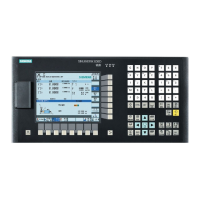Programming
10.15 Oscillation
Cylindrical grinding
Programming and Operating Manual, 07/2009, 6FC5398-4CP10-2BA0
333
Defining the sequence of motions, OSCTRL
The control settings for the movement are set with enable and reset options.
OSCTRL[oscillating axis] = (set-option, reset-option)
The set options are defined as follows (the reset options deselect the settings):
Reset options
These options are deactivated (only if they have previously been activated as setting
options).
Setting options
These options are switched over. When OSE (end position) is programmed, option 4 is
implicitly activated.
Option value Meaning
0 When the oscillation is deactivated, stop at the next reversal point (default)
only possible by resetting values 1 and 2
1 When the oscillation is deactivated, stop at reversal point 1
2 When the oscillation is deactivated, stop at reversal point 2
3 When the oscillation is deactivated, do not approach reversal point if no
spark-out strokes are programmed
4 Approach end position after spark-out
8 If the oscillation movement is canceled by deletion of the distance-to-go:
then execute spark-out strokes and approach end position if appropriate
16 If the oscillation movement is canceled by deletion of the distance-to-go:
reversal position is approached as with deactivation
32 New feed is only active after the next reversal point
64 FA equal to 0, FA = 0: Path overlay is active
FA not equal to 0, FA <> 0: Speed overlay is active
128 For rotary axis DC (shortest path)
256 0=The sparking out stroke is a dual stroke (default). 1=Single stroke.
Several options are appended with plus characters.
Example:
The oscillating motion for the Z axis should stop at the reversal point 1 when switched off.
Where
● an end position is approached,
● a changed feed acts immediately and should immediately stop the axis after the deletion
of distance-to-go.
OSCTRL[Z] = (1+4,16+32+64)

